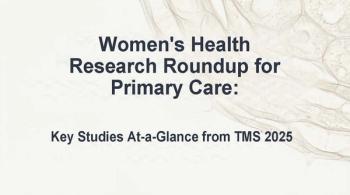
Drug Benefit Trends
- Drug Benefit Trends Vol 20 No 3
- Volume 20
- Issue 3
Prescription Drug Use Soars Among US Adults
More US adults are taking more prescription medications, fueling $12 billion in additional spending during 2006 alone, according to the Geographic Variation in Prescription Utilization study released on February 13 by Express Scripts. The number of US adults with at least 1 prescription increased from 67% in 2000 to 74% in 2006, and the number of prescriptions per capita rose from 10.8 to 14.3 in the same period-a 32% jump.
More US adults are taking more prescription medications, fueling $12 billion in additional spending during 2006 alone, according to the Geographic Variation in Prescription Utilization study released on February 13 by Express Scripts. The number of US adults with at least 1 prescription increased from 67% in 2000 to 74% in 2006, and the number of prescriptions per capita rose from 10.8 to 14.3 in the same period-a 32% jump.
The researchers examined overall prescription drug use in 40 states among 2.2 million and 3 million commercially insured US adults aged 18 to 64 years in 2000 and 2006, respectively, analyzing 7 commonly prescribed therapy classes to determine national and state trends. Medications from 4 of the therapy classes evaluated are used to manage obesity, hyperlipidemia, diabetes, and hypertension. GI drugs, analgesics/anti-inflammatories (cyclooxygenase-2 inhibitors), antidepressants, and estrogen also were studied.
Overall use and rates of increase varied significantly across geographic regions, with the South having the highest utilization and the greatest increase in use. The highest per capita spending increases for medications used to manage obesity were seen in West Virginia ($196), Kentucky ($185), Alabama ($174), Mississippi ($162), Louisiana ($154), and Arkansas ($151). The percentage of persons with at least 1 antihyperlipidemic prescription more than doubled in 36 states, increasing from 6% in 2000 to approximately 13% in 2006. Southern and lower midwestern regions experienced the highest rates of use.
The investigators also found that the percentage of US adults with at least 1 antidiabetic or antihypertensive prescription and the number of prescriptions per insured person for both therapy classes increased by more than 75%, with the greatest increases in Alabama, Georgia, Kentucky, Louisiana, and Mississippi. The lowest prevalence of antidiabetic medication use was seen in the Northeast (Maine, Massachusetts, and New Hampshire), while the prevalence of antihypertensive drug use was lowest in the West (California, Colorado, and Oregon).
Although the percentage of persons with at least 1 prescription for a GI medication increased 20%, the number of prescriptions for GI drugs per capita rose 34%. The highest prevalence was seen in Kentucky, Mississippi, Tennessee, and West Virginia in both 2000 and 2006.
The number of persons with at least 1 estrogen prescription decreased by more than half, with an approximate increase of 73% in regional variation. The highest rates of use continued to be in southern and lower midwestern states (Alabama, Arkansas, Kansas, Louisiana, and Oklahoma), while the lowest rates occurred in the Northeast (Massachusetts, New Hampshire, New Jersey, New York, and Pennsylvania).
The percentage of persons with at least 1 antidepressant prescription increased by nearly 33%, and the number of prescriptions per capita rose by 51%. Unlike other therapy classes, no geographic variation was observed with antidepressants.
“The $12 billion in additional spending in 2006 would have been much greater had the nation not increased its use of lower-cost generic drugs from 40% to 58% over the intervening years,” Emily Cox, PhD, senior director of research at Express Scripts, explained.
Pharmaceutical Companies Spend More on Marketing Than on R&D
The US pharmaceutical industry’s marketing expenditures are almost double its expenditures for R&D. Marc-Andre Gagnon, doctoral candidate, sociology department, University of Quebec, Montreal, and Joel R. Lexchin, MD, professor, School of Health Policy and Management, York University, Toronto, compared data from IMS and CAM, 2 pharmaceutical market research firms, to analyze marketing expenditures in the United States. The investigators estimated that US pharmaceutical companies spent $57.5 billion on marketing in 2004. In comparison, the National Science Foundation reported that the amount of industrial pharmaceutical R&D, including public funds, in 2004 was $31.5 billion. The study was published online in PloS Medicine on January 3.
The types of marketing and promotion included in the $57.5 billion figure were distribution of samples, detailing physicians, direct-to-consumer (DTC) advertising, medical meetings, e-mail promotions, direct mail, clinical trials, and journal advertising.
The researchers' revised estimate of $57.5 billion for 2004 US pharmaceutical marketing expenditures is significantly higher than the estimates provided by IMS ($27.7 billion) and CAM ($33.3 billion) for the same year. Although IMS and CAM gave the same estimates for the amounts spent on DTC advertising ($4 billion) and journal advertising ($0.5 billion), there were major differences between the 2 sets of figures. IMS estimated the amount spent on detailing to be $7.3 billion, whereas CAM estimated this amount to be $20.4 billion. In addition, IMS gave a retail value of $15.9 billion for samples; CAM reported a wholesale value of $6.3 billion for them. Gagnon and Lexchin added the CAM figures for detailing and other marketing expenses ($41.6 billion) after correcting for a 30% estimate of unaccounted promotion and used the IMS figure of $15.9 billion for the retail value of samples to arrive at the $57.5 billion figure.
Calcium Channel Blockers Linked to Lower PD Risk
Persons who take calcium channel blockers to manage chronic hypertension have a significantly lower risk of Parkinson disease (PD) than those who do not use the drugs, according to results of a study published online in Neurology on February 6. However, the risk of PD was not altered by long-term use of angiotensin-converting enzyme (ACE) inhibitors, angiotensin II (AT II) antagonists, or β-blockers.
Principal researcher Christoph R. Meier, PhD, University Hospital Basel, Switzerland, and colleagues conducted a case-control analysis of the United Kingdom's General Practice Research Database to evaluate the effect of antihypertensive medication use on the risk of developing first-time PD. The study included 7374 persons 40 years and older, of whom half (3637 persons) received a diagnosis of incident idiopathic PD between 1994 and 2005. Approximately 90% of the subjects received a diagnosis of PD after age 60. The investigators used the database to match a control to each person with PD based on age, sex, general practice, index date, and duration of previous history in the database. Among the persons with PD, 1704 (46.9%) had used an antihypertensive medication before the index date. Of these persons, 629 (17.3%) had used an ACE inhibitor, 89 (2.5%) had used an AT II antagonist, 1168 (32.1%) had used a β-blocker, and 807 (22.2%) had used a calcium channel blocker. Some patients with PD had used more than 1 antihypertensive drug. Odds ratios (OR) were adjusted for body mass index; smoking; various cardiovascular, metabolic, and behavioral health diseases; and dementia.
When researchers compared persons with PD who did not use hypertension drugs with those who currently used hypertension drugs and had a history of at least 30 prescriptions for such a drug, the adjusted OR was 1.08 (95% confidence interval [CI], 0.85 to 1.37) for ACE inhibitors, 0.91 (95% CI, 0.41 to 2.00) for AT II antagonists, and 1.16 (95% CI, 0.95 to 1.41) for β-blockers. The OR for calcium channel blockers was 0.77 (95% CI, 0.63 to 0.95)-a 23% reduction in risk.
FDA Expands Asmanex Indication
On February 4, the FDA approved Asmanex Twisthaler (Schering- Plough) as preventive therapy for treating asthma in children aged 4 to 11 years. Asmanex (mometasone furoate inhalation powder), the first inhaled corticosteroid for once-daily administration in young children, will be available in a 110-μg dosage. Asmanex (220 μg) received FDA approval on March 30, 2005, for asthmatic patients 12 years and older.
Articles in this issue
almost 18 years ago
Personalized Medicine: A New Medical Paradigmalmost 18 years ago
Patients or Health Care Decision Makers?almost 18 years ago
Back and Neck Pain Costs Climb Rapidlyalmost 18 years ago
New Push for Generic Biologicsalmost 18 years ago
Medical Residents With Depression More Likely to Make Medication Errorsalmost 18 years ago
Early Antidepressant Treatment Is Effective for Post-Stroke Depressionalmost 18 years ago
Effective Pharmacological Treatment Options for Anxiety Disordersalmost 18 years ago
Consumers Seek More Services, Innovation From Health Care Providersalmost 18 years ago
Ascendancy of the Transparency Model for PBMsNewsletter
Enhance your clinical practice with the Patient Care newsletter, offering the latest evidence-based guidelines, diagnostic insights, and treatment strategies for primary care physicians.
























































































































































































































































































